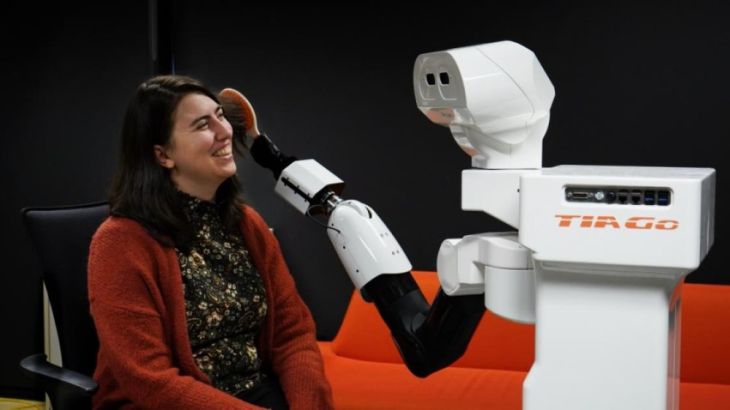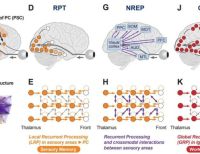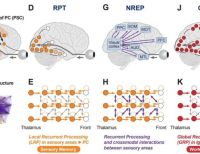Is it important to us that robots use body language when communicating?
Robots could become the personal assistants of the future, so it is important to work out how they can interact in the best possible way. Here, a robot is brushing the hair of researcher Marieke van Otterdijk. Photo: Elina Melteig
This article was first published by Titan (in Norwegian)
When you share something with a friend, a lot of the message is communicated via body language. If you feel happy, your movements are likely to be larger and your face will be lifted upwards. If you are sharing something sad, you are likely to be calmer and slower in your delivery.
Robots are rappidly being employed for a variety of services. The researchers want to find out whether it is important for robots to also use body language when communicating with us or whether it isn’t all that important – they are robots after all.
“If we find that the use of body language is not important, we will not have to spend any resources on developing it,” explains Marieke van Otterdijk, PhD candidate at RITMO and the Department of Informatics at the University of Oslo.
She is conducting research into how people and robots can communicate in the best possible manner.
 van Otterdijk uses a Pepper robot in her research. The photograph shows van Otterdijk together with a mini version of Pepper. Photo: Elina Melteig
van Otterdijk uses a Pepper robot in her research. The photograph shows van Otterdijk together with a mini version of Pepper. Photo: Elina Melteig
Body language provides an intuitive understanding of the message
One of the reasons why researchers are looking at body language as part of communication is that it provides an intuitive understanding of the message. “Body language is an important part of human communication and this is why we are good at understanding it, so good that we sometimes assign human characteristics to animals and items,” van Otterdijk claims.
“If we see a dog, we will often interpret its behaviour using human characteristics such as happiness or sadness or we can even imagine that other items like cars or phones have a personality,” she explains.
The fact that we already assign human characteristics to animals or items is precisely why we need to find out how human-like robots should be like.
“The majority of people would prefer for robots to be human-like, as it will make it easier for us to understand them if they behave like us. However, an interesting paradox is that it can also be uncomfortable for us if they become too similar to us,” says van Otterdijk.
Similarities can become uncomfortable
This paradox is best known as the uncanny valley. It is hard to predict when and why a robot will be perceived as uncanny.
“Many people argue that the uncanny valley occurs when we expect more from the robot than it is capable of. It creates friction when our expectations are not met,” van Otterdijk explains.
If a robot looks too human-like, we will also expect a human level of communication.
Housing for the elderly could be staffed by robot assistants in future.
According to van Otterdijk, the robots of the future may become important assistants that can help retrieve items and perform other simple tasks.
“Perhaps robots could help the elderly to complete forms before going to the doctor so that it is already done. This could save time for the health services,” van Otterdijk explains.
“It is not a goal for robotics to replace carers or human interaction,” says van Otterdijk. It should be a support system. There is an increasing number of elderly people and fewer people to look after them. New solutions are required. In order for the technology to be useful, it needs to be adapted to what the elderly need and want.
This is why it is important for her to ensure that the elderly play a part in the development of the technology. So far, the experiences have been divergent.
“Some of the elderly participants were not particularly interested in the robots. They could see the benefits for others but not for themselves,” van Otterdijk explains.
 Research is important to ensure that the interaction with robots is as positive as possible. This is why the researchers will ask the robots to do a variety of tasks and observe how the users perceive them. Here, van Otterdijk demonstrates the TiaGo robot putting lipstick on her. Photo: Elina Melteig
Research is important to ensure that the interaction with robots is as positive as possible. This is why the researchers will ask the robots to do a variety of tasks and observe how the users perceive them. Here, van Otterdijk demonstrates the TiaGo robot putting lipstick on her. Photo: Elina Melteig
“This one was quite cute”
She also explains that some found it useful that the robots were able to retrieve things or provide some company but that many found that the technology wasn’t particularly relevant to them as it would take a long time for the robot technology to be put into use. Some were also afraid that the technology would be extremely expensive or that the robots would replace employees at the seniors’ centre. However, van Otterdijk says that most of the elderly participants were still quite curious.
“Overall, it has been very fun to work with the elderly and robots. They enjoy seeing them and when I turn the robots on they will say things like “this one is a bit cute”. The elderly often have a million questions because they have never seen robots like these before,” van Otterdijk explains.
In her research, van Otterdijk uses a type of robot called Pepper. When she conducts her experiments she can control the robots remotely in order to adapt them to how the elderly react.
van Otterdijk tells us about an episode in which she visited a seniors’ centre for people with dementia. An elderly lady had a long conversation with the robot and named it Harry.
“When I spoke to the nurse, she told me that this lady would otherwise rarely speak,” says van Otterdijk.
This is why van Otterdijk believes that this type of robot could be useful. It provides opportunities for conversation and interaction in ways that can benefit the elderly. This gives hope that the robots can be useful, but there is also a wide range in terms of how the elderly react.
“One of the ladies attempted to introduce another lady to the robot, but she was very scared and didn’t want to get too close to it,” van Otterdijk says.
 The robot can even apply lipstick! Here you can see the results of van Otterdijk having her make-up applied by TiaGo. Photo: Elina Melteig
The robot can even apply lipstick! Here you can see the results of van Otterdijk having her make-up applied by TiaGo. Photo: Elina Melteig
We adapt body language to fit the message
In the project, the researchers tasked the robot with passing on three different types of news to the residents at the seniors’ centre. The first message was undoubtedly happy: You have a new grandchild! The second message was neutral and was about reminding the individual to take their medicine. The last message was negatively loaded. The robot had accidentally broken a mug.
“The elderly residents reacted with empathy to the last message,” van Otterdijk says. The majority showed compassion and told the robot that it wasn’t a big deal and that they had plenty of other mugs.
While passing on the messages, the robot had also been tasked with demonstrating different types of behaviour. This could entail approaching at different speeds and heading straight towards the elderly resident or being a little hesitant. In addition, the position of the head, colours and the use of gestures would also come into play.
“If the robot were to deliver good news with a sad face, it could be perceived as sarcasm. In any case, it would be perceived as very strange,” van Otterdijk says.
The results show that the majority of those who were interested in the robots also wanted the message and behaviour of the robot to match.
“Making the movements soft and designing the robots in a way that makes people like them is important. These are things we need to think about when it comes to the design and behaviour of the robot. This makes it easier for people to accept such a robot and to interact with it,” she concludes.
There were 12 participants in the project. van Otterdijk explains that considerations relating to privacy and available resources are the reason why it is difficult to include many participants in research such as this.
Read the scientific article:
M. T. H. Van Otterdijk, M. M. E. Neggers, J. Torresen and E. I. Barakova, "Preferences of Seniors for Robots Delivering a Message With Congruent Approaching Behavior," 2021 IEEE International Conference on Advanced Robotics and Its Social Impacts (ARSO), 2021







